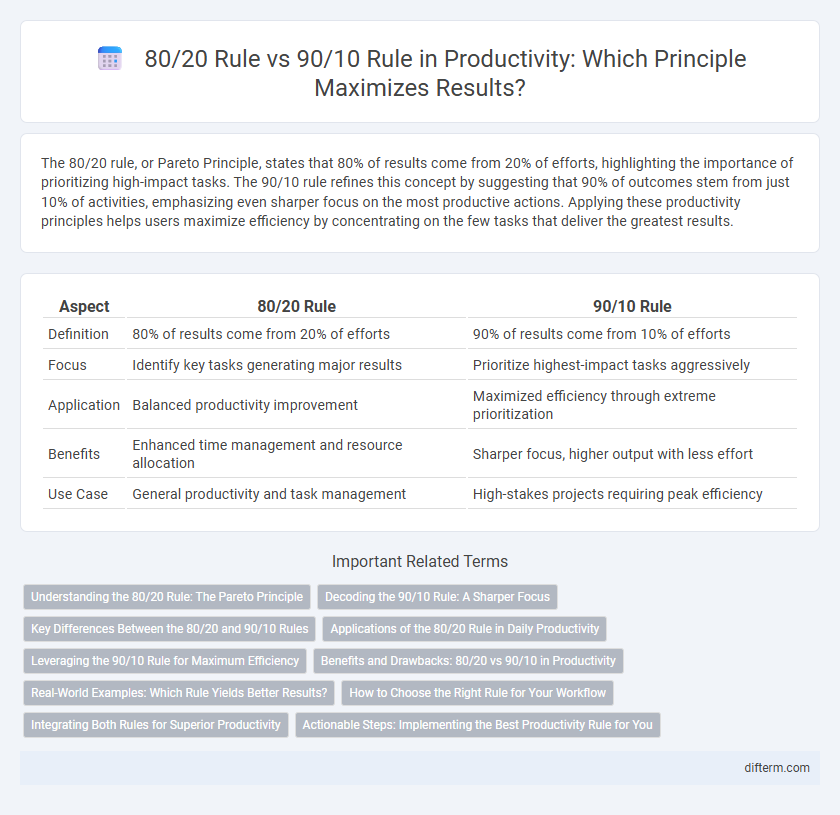The 80/20 rule, or Pareto Principle, states that 80% of results come from 20% of efforts, highlighting the importance of prioritizing high-impact tasks. The 90/10 rule refines this concept by suggesting that 90% of outcomes stem from just 10% of activities, emphasizing even sharper focus on the most productive actions. Applying these productivity principles helps users maximize efficiency by concentrating on the few tasks that deliver the greatest results.
Table of Comparison
| Aspect | 80/20 Rule | 90/10 Rule |
|---|---|---|
| Definition | 80% of results come from 20% of efforts | 90% of results come from 10% of efforts |
| Focus | Identify key tasks generating major results | Prioritize highest-impact tasks aggressively |
| Application | Balanced productivity improvement | Maximized efficiency through extreme prioritization |
| Benefits | Enhanced time management and resource allocation | Sharper focus, higher output with less effort |
| Use Case | General productivity and task management | High-stakes projects requiring peak efficiency |
Understanding the 80/20 Rule: The Pareto Principle
The 80/20 Rule, also known as the Pareto Principle, asserts that roughly 80% of results come from 20% of causes, highlighting the unequal distribution of effort and output in productivity. This principle aids in identifying the most impactful tasks or inputs that drive the majority of outcomes, enabling focused effort on high-value activities. Applying the 80/20 Rule enhances efficiency by eliminating time spent on less productive tasks and maximizing the impact of limited resources.
Decoding the 90/10 Rule: A Sharper Focus
The 90/10 rule sharpens productivity by emphasizing that 90% of results come from just 10% of efforts, refining the Pareto 80/20 principle for greater impact. Focusing on the most critical tasks that generate maximum output enables a more efficient allocation of time and resources. This approach drives higher productivity through pinpointed prioritization and elimination of distractions.
Key Differences Between the 80/20 and 90/10 Rules
The 80/20 rule, or Pareto Principle, states that 80% of outcomes result from 20% of inputs, emphasizing efficient resource allocation and prioritization. In contrast, the 90/10 rule suggests an even more concentrated effect, where 90% of results come from just 10% of efforts, highlighting the importance of identifying the most critical tasks for maximum productivity. Key differences include the degree of concentration in effort versus result ratios and their applicability in varying productivity and business contexts for optimizing focus and returns.
Applications of the 80/20 Rule in Daily Productivity
The 80/20 rule, also known as the Pareto Principle, states that 80% of results come from 20% of efforts, guiding individuals to prioritize tasks with the highest impact for improved efficiency. In daily productivity, this principle helps identify critical activities such as focused work periods and key client interactions that drive the majority of outcomes. The 90/10 rule, a refined variation, suggests even greater concentration on the most effective efforts by indicating that 90% of results stem from 10% of inputs, further sharpening task prioritization strategies.
Leveraging the 90/10 Rule for Maximum Efficiency
The 90/10 rule emphasizes prioritizing the top 10% of tasks or inputs that yield 90% of desired outcomes, driving higher productivity compared to the traditional 80/20 rule. Leveraging this principle enables professionals to focus intensely on critical activities that maximize efficiency and impact. Data shows adopting the 90/10 mindset leads to sharper decision-making, reduced time waste, and amplified results in high-performance environments.
Benefits and Drawbacks: 80/20 vs 90/10 in Productivity
The 80/20 rule emphasizes that 80% of results come from 20% of efforts, enabling individuals to focus on high-impact tasks and achieve substantial productivity gains with minimal input. The 90/10 rule, while more stringent, suggests that 90% of outcomes stem from just 10% of activities, which can drive intense prioritization but may overlook important secondary tasks, reducing overall balance. Choosing between these rules depends on the precision required in task management and the tolerance for neglecting less critical activities that still contribute to long-term productivity.
Real-World Examples: Which Rule Yields Better Results?
The 80/20 rule, or Pareto Principle, highlights that 80% of results come from 20% of efforts, commonly applied in business sales where a minority of clients generate majority revenue. The 90/10 rule narrows this focus, suggesting that 90% of productivity emerges from 10% of tasks, often seen in high-impact projects within tech startups emphasizing key development phases. Real-world evidence favors the 90/10 rule in fast-paced environments demanding rapid innovation, while the 80/20 rule suits broader strategic planning and resource allocation.
How to Choose the Right Rule for Your Workflow
The 80/20 rule emphasizes focusing on the 20% of tasks that generate 80% of results, making it ideal for workflows requiring broad efficiency improvements. The 90/10 rule targets an even smaller subset of high-impact activities, perfect for hyper-focused workflows demanding maximum output from minimal effort. Choosing the right rule depends on task complexity and desired productivity gains, balancing effort and impact to optimize workflow performance.
Integrating Both Rules for Superior Productivity
The 80/20 rule highlights that 80% of results come from 20% of efforts, while the 90/10 rule emphasizes that 90% of outcomes stem from 10% of actions, both revealing the critical importance of high-impact tasks. Integrating these principles enables prioritization of core activities that drive maximum productivity by focusing on the most influential inputs and streamlining workflows. Leveraging the combined power of the 80/20 and 90/10 rules creates a strategic framework for superior efficiency and consistent achievement of key objectives.
Actionable Steps: Implementing the Best Productivity Rule for You
The 80/20 rule, or Pareto Principle, suggests focusing on the 20% of tasks that yield 80% of results, while the 90/10 rule emphasizes identifying the critical 10% of actions driving 90% of productivity. To implement the best productivity rule, analyze task impact through time tracking and prioritize high-value activities using tools like Eisenhower Matrix or time-blocking strategies. Regularly review outcomes to adjust focus and maximize efficiency tailored to individual work patterns.
80/20 rule vs 90/10 rule Infographic

 difterm.com
difterm.com